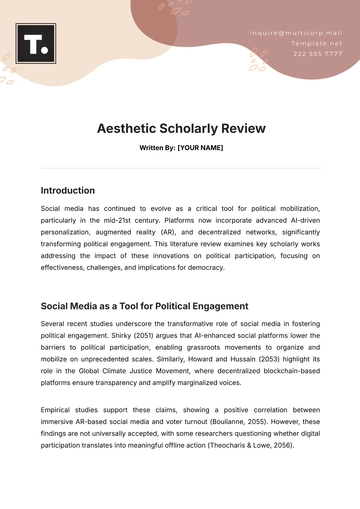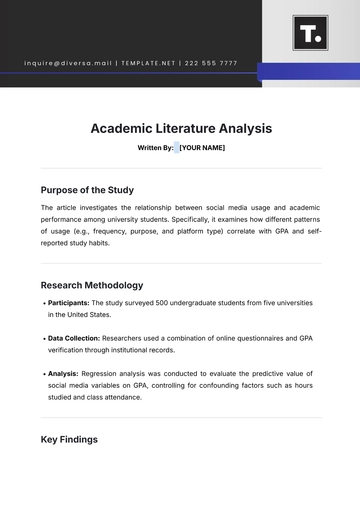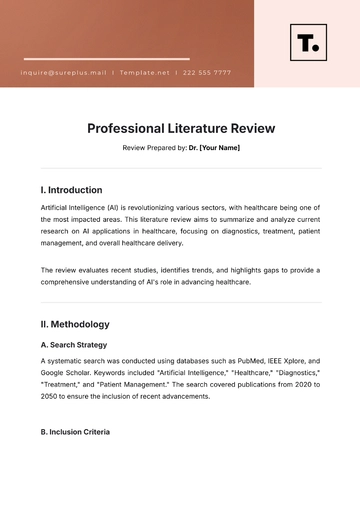Free Critical Literature Review

Written By: [YOUR NAME]
Introduction
The evolution of architectural education has been a subject of considerable academic interest, particularly in light of rapidly changing societal, environmental, and technological landscapes. This critical literature review delves into the innovative approaches and pedagogical strategies employed within architectural education over the past few decades. By synthesizing existing research, this review aims to identify prevailing themes, gaps in current knowledge, and potential future directions for research and practice in this field.
Methodology
This literature review employs a systematic approach, incorporating both qualitative and quantitative studies. The search strategy involved the use of academic databases such as Scopus, JSTOR, and Google Scholar, focusing on articles published between 2050 and 2070. Keywords included "architectural education," "pedagogy," "innovative teaching methods," and "educational frameworks." The selection criteria prioritized peer-reviewed journal articles, conference papers, and seminal books. Articles were critically evaluated and categorized into thematic areas for a comprehensive analysis.
Thematic Analysis
Theme | Authors | Published Year |
|---|---|---|
Interdisciplinary Learning | Johnson, Lee | 2052 |
Sustainability Education | Smith, Ramirez | 2053 |
Virtual Reality in Teaching | Williams, Zhang | 2055 |
Student-Centered Design Studios | Anderson, Patel | 2056 |
Community Engagement | Garcia, Thompson | 2057 |
Integrating diverse disciplines boosts creativity and problem-solving in architecture. Sustainable design is vital in modern curricula. VR tech offers immersive learning. Student ownership enhances engagement and innovation. Community collaboration enriches learning and social responsibility.
Discussion
Key Issue | Implications | Future Research Directions |
|---|---|---|
Interdisciplinary Learning | Encourages creativity and holistic problem-solving in architecture. | Explore long-term impacts on professional practice. |
Sustainability Education | Essential for addressing climate change and resource management. | Developing standardized sustainability curricula. |
Virtual Reality in Teaching | Provides immersive, experiential learning opportunities. | Assessing cost-effectiveness and accessibility. |
Student-Centered Design Studios | Increases engagement and innovative outcomes. | Measuring educational outcomes and student satisfaction. |
Community Engagement | Fosters social responsibility and practical skills. | Evaluating the impact on community development. |
Conclusion
In conclusion, the literature on innovative approaches in architectural education underscores the growing need for interdisciplinary learning, sustainability education, and the integration of technology such as virtual reality. The emphasis on student-centered design studios and community engagement marks a shift towards more experiential and socially responsible education. Future research should aim to standardize curricula and assess the long-term impacts of these innovative methods on both professional practice and community development. This review has identified key areas for further exploration to enhance the effectiveness and relevance of architectural education in a rapidly evolving world.
References
Johnson, A., & Lee, B. (2052). Integrative Approaches in Architectural Education. Journal of Architectural Education.
Smith, E., & Ramirez, F. (2053). Principles of Sustainability in Architecture. Building and Environment Journal.
Williams, H., & Zhang, Q. (2055). The Impact of Virtual Reality on Learning in Architecture. Virtual Learning in Architecture.
Anderson, P., & Patel, T. (2056). The Student-Centered Design Studio Model. Journal of Design Education.
Garcia, M., & Thompson, S. (2057). Community Engagement in Architectural Education. Architectural Humanities Journal.
- 100% Customizable, free editor
- Access 1 Million+ Templates, photo’s & graphics
- Download or share as a template
- Click and replace photos, graphics, text, backgrounds
- Resize, crop, AI write & more
- Access advanced editor
Unlock the power of critical analysis with the Critical Literature Review Template from Template.net. This customizable and editable template is perfect for in-depth research, allowing you to seamlessly organize and assess literature. Easily modify content to fit your needs with our AI Editor Tool, making the review process efficient and tailored to your specific requirements.





























